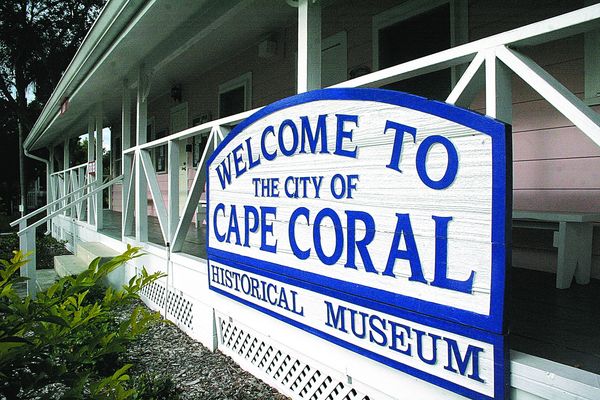History of Cape Coral Bridge goes back to 1961

Tom Hayden
As Lee County continues a plan to replace the westbound span of the Cape Coral Bridge by 2028, the 57-year history of this one-mile structure features stories of development, growth and traffic for the Cape community.
The stories start in 1961 when discussions began on building a bridge that provided a much easier connection for Cape residents to Fort Myers. Then, some residents opposed a structure saying it would increase property taxes and disturb the community’s “quiet existence.”
But many more wanted the bridge to help reduce travel times across the Caloosahatchee from about 30 minutes to five. In 1961, the Cape Coral Freeholders voted 174-124 to create the Cape Coral Roads and Bridge District, launching a plan to fund and build the bridge.
On Dec. 21, 1962, the first shovels hit the ground to start construction on the $2 million project. On hand for the groundbreaking were Miss Cape Coral Roberta Blackwell; Cape Coral engineer Tom Weber, who was a vice-president for Gulf American Corporation; Connie Mack Jr., also a VP with GAC; and Lee County Commissioner Mack Jones.
In the meantime, the Rosen brothers, who developed the community, put up $100,000 with the county to guard against raising taxes on residents. “If the county won’t build it, I’ll build it myself,” Leonard Rosen said at the time. The county used tolls to help pay for the two-lane bridge.

After a 15-month construction project, city leaders and county dignitaries gathered for a ribbon-cutting ceremony to open the bridge on March 14, 1964. Cutting the ribbon were Kenny Schwartz, the community’s first resident and vice president for GAC, along with his wife and children. The guest speaker was T.J. Stephens, a U.S. Coast Guard Rear Admiral with the 7th District.
The bridge opened for traffic at 1:30 p.m. the day of dedication. Vehicles lined up for the historic journey and passed slowly over the new structure. Trips were free until 6 p.m. when a toll of 25 cents kicked in.
By November, half a million vehicles had crossed the bridge. In fact, Mildred Marchyshyn received a bouquet of roses for being the 500,000th driver. How tremendous was the growth? A feasibility study had suggested the bridge would not hit half a million vehicles until February 1965.
The bridge was a direct connection to growth in the Cape. There was a 300 percent increase in new industry with 11 new firms opening in the industrial park. Commercial growth expanded along Cape Coral Parkway. Cape Coral Bank had just opened a month earlier near the foot of the bridge. The first Publix Supermarket opened on the parkway at a cost of $350,000.
By 1967, 4 million vehicles had passed over the bridge as the gateway of discovery continued with 8,000 residents calling the community home. From that opening day in 1964 through June 30, 1968, 5,572,380 vehicles passed over the bridge paying $1,162,788 in tolls.
In 1970, the bridge hit another milestone, with 10 million vehicles crossing it. After several years of fluctuating tolls that at one time dropped to 10 cents a trip, the bond on the bridge was paid off on Nov. 30, 1974, and tolls were lifted.
But growth created a need for a second, parallel span, and the eastbound bridge opened in 1989. To pay for the one-mile, two-lane structure, tolls were reinstituted at 75 cents, raising to $1 in each direction in November 1993.
That brings us to today and plans for the new, three-lane westbound bridge. The age of the current bridge and high traffic counts, exceeding 47,000 trips a day, have created the need for a new structure. Design plans are under way for the bridge, estimated to cost $108 million. The old bridge will likely be removed after the new structure opens, although some residents have asked for it to be save as a linear park and pedestrian walkway. A third lane will be added to the eastbound bridge as well.
Tom Hayden is a Cape Coral Museum of History board member and a Cape Coral City Council member, representing District 3. He writes a column twice a month for the Cape Coral Breeze on the city’s history.



